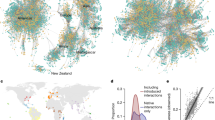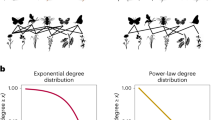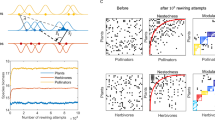Abstract
The interactions between plants and their animal pollinators and seed dispersers have moulded much of Earth’s biodiversity1,2,3. Recently, it has been shown that these mutually beneficial interactions form complex networks with a well-defined architecture that may contribute to biodiversity persistence4,5,6,7,8. Little is known, however, about which ecological and evolutionary processes generate these network patterns3,9. Here we use phylogenetic methods10,11 to show that the phylogenetic relationships of species predict the number of interactions they exhibit in more than one-third of the networks, and the identity of the species with which they interact in about half of the networks. As a consequence of the phylogenetic effects on interaction patterns, simulated extinction events tend to trigger coextinction cascades of related species. This results in a non-random pruning of the evolutionary tree12,13 and a more pronounced loss of taxonomic diversity than expected in the absence of a phylogenetic signal. Our results emphasize how the simultaneous consideration of phylogenetic information and network architecture can contribute to our understanding of the structure and fate of species-rich communities.
This is a preview of subscription content, access via your institution
Access options
Subscribe to this journal
Receive 51 print issues and online access
$199.00 per year
only $3.90 per issue
Buy this article
- Purchase on Springer Link
- Instant access to full article PDF
Prices may be subject to local taxes which are calculated during checkout




Similar content being viewed by others
References
Ehrlich, P. R. & Raven, P. H. Butterflies and plants: a study in coevolution. Evol. Int. J. Org. Evol. 18, 586–608 (1964)
Thompson, J. N. The Geographic Mosaic of Coevolution (Univ. Chicago Press, Chicago, 2005)
Waser, N. M. & Ollerton, J. Plant–Pollinator Interactions: from Specialization to Generalization (Univ. Chicago Press, Chicago, 2006)
Jordano, P., Bascompte, J. & Olesen, J. M. Invariant properties in coevolutionary networks of plant–animal interactions. Ecol. Lett. 6, 69–81 (2003)
Bascompte, J., Jordano, P., Melián, C. J. & Olesen, J. M. The nested assembly of plant–animal mutualistic networks. Proc. Natl Acad. Sci. USA 100, 9383–9387 (2003)
Bascompte, J., Jordano, P. & Olesen, J. M. Asymmetric coevolutionary networks facilitate biodiversity maintenance. Science 312, 431–433 (2006)
Memmott, J., Waser, N. M. & Price, M. V. Tolerance of pollination networks to species extinctions. Proc. R. Soc. Lond. B 271, 2605–2611 (2004)
Vázquez, D. P. & Aizen, M. A. Asymmetric specialization: a pervasive feature of plant–pollinator interactions. Ecology 85, 1251–1257 (2004)
Thompson, J. N. Mutualistic webs of species. Science 312, 372–373 (2006)
Freckleton, R. P., Harvey, P. H. & Pagel, M. Phylogenetic analysis and comparative data: a test and review of evidence. Am. Nat. 160, 712–726 (2002)
Blomberg, S. P., Garland, T. & Ives, A. R. Testing for phylogenetic signal in comparative data: Behavioral traits are more labile. Evol. Int. J. Org. Evol. 57, 717–745 (2003)
Purvis, A., Agapow, P.-M., Gittleman, J. J. & Mace, G. M. Nonrandom extinction and the loss of evolutionary history. Science 288, 328–330 (2000)
Heard, S. B. & Mooers, A. Ø. Phylogenetically patterned speciation rates and extinction risks change the loss of evolutionary history during extinctions. Proc. R. Soc. Lond. B 267, 613–620 (2000)
Ives, A. R. & Godfray, C. J. Phylogenetic analysis of trophic associations. Am. Nat. 168, E1–E14 (2006)
Armbruster, W. S. Phylogeny and the evolution of plant–animal interactions. Bioscience 42, 12–20 (1992)
Herrera, C. M. Historical effects and sorting processes as explanations for contemporary ecological patterns: character syndromes in Mediterranean woody plants. Am. Nat. 140, 421–446 (1992)
Jordano, P. Angiosperm fleshy fruits and seed dispersers: a comparative analysis of adaptation and constraints in plant–animal interactions. Am. Nat. 145, 163–191 (1995)
Waser, N. M., Chittka, L., Price, M. V., Williams, N. M. & Ollerton, J. Generalization in pollination systems, and why it matters. Ecology 77, 1043–1060 (1996)
Albert, R., Barabási, A.-L. & Jeong, H. The Internet’s Achilles’ Heel: Error and attack tolerance in complex networks. Nature 406, 378–382 (2000)
Montoya, J. M., Pimm, S. L. & Solé, R. V. Ecological networks and their fragility. Nature 442, 259–264 (2006)
Wheelwright, N. T. Fruit size in a tropical tree species—variation, preference by birds, and heritability. Vegetatio 108, 163–174 (1993)
Fenster, C. B., Armbruster, W. S., Wilson, P., Dudash, M. R. & Thompson, J. D. Pollination syndromes and floral specialization. Annu. Rev. Ecol. Evol. Syst. 35, 375–403 (2004)
Bronstein, J. L., Alarcón, R. & Geber, M. The evolution of plant–insect mutualisms. New Phytol. 172, 412–428 (2006)
Cattin, M.-F., Bersier, L.-F., Banasek-Richter, C., Baltensperger, R. & Gabriel, J.-P. Phylogenetic constraints and adaptation explain food-web structure. Nature 427, 835–839 (2004)
Garland, T. A. Bennett, F. & Rezende, E. L. Phylogenetic approaches in comparative physiology. J. Exp. Biol. 208, 3015–3035 (2005)
Legendre, P. & Legendre, L. Numerical Ecology 2nd edn 254–256 (Elsevier, Amsterdam, 1998)
Clarke, K. R. & Warwick, R. M. A taxonomic distinctness index and its statistical properties. J. Appl. Ecol. 35, 523–531 (1998)
Acknowledgements
We thank S. Armbruster, P. Buston, M. A. Fortuna, P. Guimarães, M. Helmus, A. Ives, J. Olesen, D. Posada, A. G. Sáez, J. N. Thompson and N. Waser for comments on a previous draft. This work was funded by the European Heads of Research Councils, the European Science Foundation, and the EC Sixth Framework Programme through a EURYI (European Young Investigator) Award (J.B.), by the Spanish Ministry of Education and Science (P.J. and J.B.), by the Junta de Andalucía (P.J. and J.B.), and by the Fundação de Amparo à Pesquisa do Estado de São Paulo (P.R.G).
Author Contributions E.L.R. performed all the analysis and compiled the phylogenies jointly with J.E.L. P.R.G. performed the extinction simulations. P.J. and J.B. designed the study and compiled the interaction matrices. E.L.R. and J.B. wrote a first version of the manuscript, and all authors contributed to the final draft.
Author information
Authors and Affiliations
Corresponding author
Ethics declarations
Competing interests
Reprints and permissions information is available at www.nature.com/reprints. The authors declare no competing financial interests.
Supplementary information
Supplementary Information
This file contains Supplementary Methods, Supplementary Table 1, Supplementary Figures 1-3, additional references and all the phylogenies compiled for this study. (PDF 6238 kb)
Supplementary Data and Methods
This file contains Supplementary Data with the entire database listing (i) interaction matrices used in this study; (ii) species list and their information and (iii) results from statistical analysis summarized in main text and Supplementary Methods. (XLS 6259 kb)
Rights and permissions
About this article
Cite this article
Rezende, E., Lavabre, J., Guimarães, P. et al. Non-random coextinctions in phylogenetically structured mutualistic networks. Nature 448, 925–928 (2007). https://doi.org/10.1038/nature05956
Received:
Accepted:
Issue Date:
DOI: https://doi.org/10.1038/nature05956
This article is cited by
-
Novel plant–frugivore network on Mauritius is unlikely to compensate for the extinction of seed dispersers
Nature Communications (2023)
-
Nutritional redundancy in the human diet and its application in phenotype association studies
Nature Communications (2023)
-
Forest edges increase pollinator network robustness to extinction with declining area
Nature Ecology & Evolution (2023)
-
This flower is our bed: long-term citizen science reveals that hummingbird flies use flowers with certain shapes as sleeping places
Arthropod-Plant Interactions (2023)
-
Estimating comparable distances to tipping points across mutualistic systems by scaled recovery rates
Nature Ecology & Evolution (2022)
Comments
By submitting a comment you agree to abide by our Terms and Community Guidelines. If you find something abusive or that does not comply with our terms or guidelines please flag it as inappropriate.



